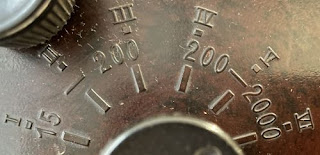An extra tube E462.
- Philips radio's 938A and 172A (1934) -
 |
| My Philips 938A |
 |
| Advertisement for the Philips 938A (March 1934) |
In March 1934 Philips introduced the Philips 938A radio for the Dutch East Indies market. It is a simple regenerative TRF receiver with 2 AF stages. It has 4 tubes:
- E438: detector
- E438: RF amplifier
- C453: output penthode
- 1823: rectifier
The radio is a so-called "world receiver" with wave ranges from 15 to 2000 meters:
- I: 15 - 33 meter
- II: 32 - 90 meter
- III: 85 - 200 meter
- IV: 200 - 400 meter
- V: 400 - 950 meter
- VI: 950 - 2000 meter
 |
| Waveranges on the Philips 938A |
Price was 97.50 guilder. This was the cheapest Philips radio that was for sale in 1934. Price is comparable to the "Arbeiderskastje" (Workers' case) Philips 836A that appeared on the market in the Netherlands in 1934. But it was still an expensive radio compared to American (US) radios that were often already superheterodyne and were also cheaper. But Philips filed lawsuits against anyone who tried to import and sell these radios in the Dutch East Indies. This because of patent rights. So Philips was dominant in the Dutch East Indies market as far as radios are concerned. Erres is a close second. Philips kept prices artificially high and many complained about this.
For example, this letter to the editor in a newspaper from 1937 (See illustration below): The writer complains about the enormous profits that Philips (and others) makes because of their monopoly on the Dutch East Indies market for radios, radio lamps and light bulbs. This compared to (in technology) superior radios from the US. He takes the Erres KY222 as an example. Buying this radio for Borsumij (the wholesaler) costs 81.11 guilders, without tubes. The fixed selling price to the public is 375.00 guilders. A 'profit' of 293.89 guilders. Of course, the price of the radiotubes, advertising costs, transport, administration, transport, import duties, etc. must be deducted from this. But the biggest expense will be the radio tubes (Philips !).
 |
| Sipatahoenan (newspaper) July 18, 1937 (Language is Sundanese) |
In May or June 1934 the PTT (Public Postal Telegraph and Telephone service) announced that "radiating devices" were no longer allowed, and that all devices had to be tested by the PTT first. If the radio passed the test, a certificate was issued. The Philips 938A did not meet the requirements and had to be adapted.
So Philips got to work and developed the Philips 172A. In fact no more than a Philips 938A with an extra radio tube E462. Existing Philips 938A devices could thus be adapted with an extra E462 tube in order to meet the requirements of the PTT and to obtain a permit. Of course one had to pay for this and one lost one's radio for a day. The new Philips 172A was more expensive than its almost identical predecessor 938A: 120 guilders. The conversion from a 938A to a 172A probably also cost about 22 guilders.
 |
| advertisement for the Philips 172A (1935) Indonesian language. |
Why the modified radio was given the type number "172A"? Simple: 0000 minus 938 is 172 (?) That's the explanation given at the time... Yes, 9+1 and 3+7 and 8+2 makes 10 every time. But the explanation is a bit vague. Anyway...
 |
| Sumatra Post 1934 about "Radiating divices" |
I have never seen a converted 938A, so with an extra E462 radio tube. The 938A is not very rare, but also not very easy to find. The 172A is a different story: I know 2 radios so far. It is not certain whether this radio was only sold in the Dutch East Indies, because 1 example is known in Brazil.
In the Dutch East Indies at that time there were many protests against the strict rules of the PTT. Rules that were much stricter than in the Netherlands. Now we come to the complex differences between the Netherlands and its colony the Dutch East Indies. Yes, D.E.I. were part of the Kingdom of the Netherlands, but with their own laws and customs.
A good example is the development of the NIROM. They did not want be a copy of the pillarized (Dutch: "verzuiling") broadcasting system in the Netherlands. Pillarized in this case means a strong influence of the Church (Protestant and Roman Catholic). The NIROM had to become a "neutral" broadcaster. So the NIROM became a "neutral" broadcaster without too much religious influence. That is why it took until the early 1930s before NOROM started broadcasting. The input and forces from the Netherlands tried to get a grip...
After the Philips 938A and the 172A, the superheterodynes came onto the market, such as the Philips 334A and the 335A. As is the case in technology, these devices were superior to the previous radios. Especially for the Philips 334A was made very public as "The bang receiver" (Dutch: "Knalontvanger"). It should also be remembered that it was only from 1934 that the NIROM network started to develop and that it was therefore only from that moment on that it became interesting for many people to purchase a radio set.
Since then the sale of radio sets in the Dutch East Indies has been booming.
(Makasih banyak to pak Prayudi dari Jogya atas saran dan masukannya !)
Geen opmerkingen:
Een reactie posten